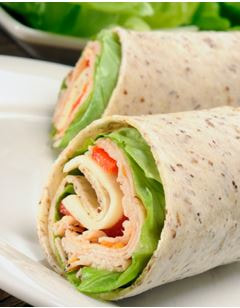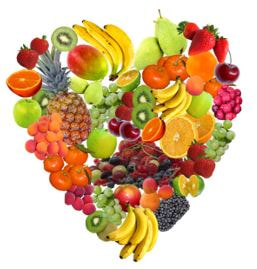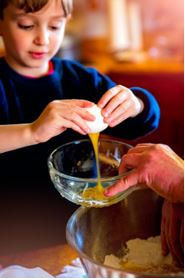|
Melissa Gaudreau, STOTT Pilates Instructor TIP The most basic aspect of the Pilates method is sitting tall, looking forward and avoiding slouching. Good Posture: Pilates will teach you to gain and maintain good posture. The exercises require that your body is always in alignment. This is especially beneficial if you suffer from lower back pain. Muscle Tone: The exercises involve the use of muscles that you may not use on a daily basis. This is especially good for those who are normally quite sedentary in their daily life as well as older people because muscle tone is usually lost with inactivity and age. Stronger Core: One of the benefits of Pilates is that it will result in a flatter tummy because it focuses on strengthening your core, which includes your abdominal muscles. Less Back Pain: Back pain mostly results from faulty posture and a sedentary lifestyle. Pilates addresses the muscle imbalances that most typically contribute to back pain, namely weak abdominals and glute muscles. Pilates also stretches out the tight and overworked back muscles. Proper alignment is the main factor that helps to alleviate back pain. If you do Pilates, you’ll understand how to use your body in ways that protect your back from injury. Flexibility: Pilates exercises stretch the muscles and the joints while they strengthen the body. As we age, we tend to lose the flexibility we had when we were young. Pilates helps restore flexibility. This is especially important in order to avoid injuries from falls. REMEMBER Everyone has physical limitations that depend on age, genetics, and lifestyle. Pilates is not a panacea, but if you do a regular Pilates exercise program, your body can reach its potential in the areas of flexibility and strength. More Awareness: If nothing else, doing Pilates should give you a new awareness of your body. You may never have thought about pulling in your tummy, sitting up tall, or keeping your shoulder blades down away from your ears. And you may never have thought a lot about how you breathe. The things you discover in Pilates will start to filter into your daily life, and you may find that you correct your own posture and habits naturally. TIP: Walk the Right Way When you stride down the street, think of walking with a long stride, initiating the movement from the hips and glutes, not just the knees. This way of walking increases the length of your stride while stretching out the front of your hips (hip flexors). Walking with long strides helps reverse the tightness in the hips and back that comes from long bouts of sitting. Better Balance: Through the mind-body connection which is taught in Pilates, you will become much more aware of how your body moves and performs. Therefore, Pilates not only improves your physical balance through correct posture, but also restores your mind-body balance. Greater Strength: Any exercise regimen should increase your body’s overall strength. But Pilates strengthens the muscles in your body that you may actually notice on a day-to-day basis. Whatever activity you do, you’ll find that Pilates exercises improve strength in meaningful ways and can help with the overall health of your spine. Doing Pilates can prevent injuries, too! Reduces Stress: When doing the exercises, you'll be totally engrossed and won't be able to think about all those responsibilities that weigh you down on a day-to-day basis. You'll be more focused on your breathing and on the moves that you are making with your body. This is an excellent way to relieve stress. Introduce Pilates to your weekly routine, but be patient. No exercise program works miracles. Changes in your body will become apparent if you maintain a regular Pilates program. “Change happens through movement and movement heals." - Joseph Pilates “The mind, when housed within a healthy body, possesses a glorious sense of power." - Joseph Pilates Pilates isn't just for fitness fanatics. It's a complete fitness method to build strength in your core muscles for better posture, balance and flexibility, and when performed regularly, it positively changes bodies. It combines awareness of the spine, proper breathing and strength, and flexible training. Research has found that Pilates can be an effective treatment for injuries and illnesses such as:
It is also excellent for athletes, dancers, and other sports professionals who have had some kind of injury and need rehabilitation to get back into top form. Because Pilates is a low-impact exercise, it can be tailored to work on certain areas of your body as long as you have a trained and qualified instructor – like me. :) “Every moment of our life can be the beginning of great things." - Joseph Pilates
0 Comments
Stephanie MacNeill, RD Injuries are an unfortunate and sometimes unavoidable aspect of participation in sport and exercise. Treatment options for injury often include rest, ice, massage, manual therapy, heat, electrical stimulation, and acupuncture. An often overlooked intervention is nutrition. To understand the potential of food to help in the healing process, we first need to understand a little bit about the stages of injury. Most exercise-related injuries go through three main stages in the recovery process. In the first stage, which lasts anywhere from 1-7 days, pain, swelling, redness and heat draws chemicals to the injured area to start the healing process and increase blood flow to the area. In the second stage, which can start as early as day 4 and last about 6 weeks, inflammation begins to settle down and the body starts to repair the damaged tissue by laying down collagen. These new collagen fibres are put down in the form of scar tissue, which is weaker and less flexible than normal tissues. In the third stage which starts around 2-3 weeks post injury, healing continues to progress and the collagen fibres improve in quality, organization and strength. Nutrition plays an important role in each of these stages. Stage 1
Although inflammation is a critical part of triggering the repair process, too much may cause more damage. During this phase, try to include more anti-inflammatory fats in your diet. These include:
At the same time, try to limit pro-inflammatory foods like:
Stage 2 and 3 In these stages, metabolism may increase anywhere from 15-50% to support new tissue growth. So you'll need more calories than when you are sedentary, but fewer than when you are training and exercising regularly. Over the course of the day:
Unlock Foods Potential to Heal Next time you find yourself sidelined with an injury, consider adding a registered dietitian to your treatment team to help ensure that you are getting the right nutrients to support your body in healing. Melissa Gaudreau, STOTT Pilates Instructor  Pilates is a system of exercises using various props and special equipment, designed to improve physical strength, flexibility, posture, and enhance mental awareness and overall well-being. Pilates emphasizes your body’s core — the abdomen, obliques, lower back, inner and outer thighs and glutes. For this reason, Pilates develops much of what exercisers need — strength, flexibility, muscular endurance, coordination, balance, and good posture — with a much lower chance of injury than with other forms of exercise. This discipline emphasizes correct form. Pilates moves require you to engage virtually your whole body. At times, you may strengthen one muscle while stretching another. The moves take lots of concentration; you can’t simply go through the motions like you can on gym equipment. And then, for every move you think you’ve mastered, Pilates has another version that’s a little different and a little harder. Pilates teaches you to think about how you use your muscles during your workout so you use them better in daily life. For instance, because much of the focus is on good posture and body mechanics, you stand and sit taller, and walk more gracefully. Pilates also focuses on the mind-body connection. While doing the various exercises, your mind needs to be constantly aware of your breathing and the way your body moves. Although there are similarities between yoga and Pilates, yoga is a more relaxing form of exercise that tends to focus more on spiritual well-being, whereas Pilates is more of a physical program which focuses on toning and strengthening. Pilates is named after its inventor, a German physical fitness specialist Joseph Pilates, a former carpenter and gymnast who invented the exercise for injured dancers. Many of the moves were inspired by the principles from the ancient Greeks and how they trained their Olympians. He had a great library and was always studying - he was a genius of the body. “Pilates is designed to give you suppleness, natural grace, and skill that will be unmistakably reflected in the way you walk, in the way you play, and in the way you work." - Joseph Pilate
Stephanie MacNeill Lifestyle factors, including good nutrition and adequate exercise, have the potential to influence our health. A nutritious diet can help prevent illness and can help lower the risk of developing chronic diseases like Type 2 diabetes, heart disease, stroke, dementia and certain types of cancer. In fact, almost 80 per cent of premature stroke and heart disease can be prevented through healthy lifestyle behaviours (such as eating healthy, being active, and living smoke free). What's Best? There are many diets or eating patterns, some healthier than others. So you may be wondering, which eating pattern is best? The reality is that there is no one absolutely, positively best diet for everyone. Everyone differs in terms of their:
So the best eating pattern is one that you enjoy and can stick to even on your worst days-not just your best. Dietitians can help you follow a healthy eating pattern suited to your individual needs and health goals. Building a Balanced Diet
A basic healthy diet for disease prevention includes the following foods:
Notice anything missing from these basic ingredients? They don't contain a lot of highly processed foods with a lot of added sugar, salt and trans fat. Work With a Dietitian Consider working with a dietitian if you have health goals or concerns about your risk of chronic disease. We will work with you to embrace food, understand it, and to enjoy it while considering your overall objectives, needs, and challenges. As dietitians, we look beyond fads and gimmicks to deliver reliable, life-changing advice. Stephanie MacNeill Role: Registered Dietitian Stephanie, the newest member of our team, is our registered dietitian. See her full bio here. Qualifications: BSc. Kinesiology BSc. Nutrition and Dietetics MHSc (c) Nutrition Communication What is your favourite part of your job? The favourite part of my job is helping others be the healthiest version of themselves. What is your favourite sport to watch? Hockey!! Although summer is my favourite season, the morning sports highlights just aren't the same without hockey. Have you ever needed sports medicine or therapy? Yes! As a competitive runner and former varsity athlete I've needed my share of sports medicine therapy. Most recently I tore one of my hip flexors at the end of a running workout (grass was slippery, footing wasn't great) ...not fun! If you a crayon in a Crayola box, what colour would you be and why?
Purple-it combines the stability of the colour blue and the energy of the colour red. It also happens to be my favourite colour. What cartoon character best represents you? Belle-she was my favourite Disney cartoon character growing up, and I admire her bravery, independence and intelligence. Stephanie MacNeill, RD In this, the second week of Nutrition Month, I'm going to discuss foods potential to discover: Foster healthy eating habits in children by teaching them to shop and cook. In a culture that is increasingly relying on heavily processed, packaged and take-out foods, many children are growing up lacking basic food skills, including how to shop, cook and build a balanced meal. Teaching children from a young age, how to shop for and prepare healthy meals can set them up for a lifetime of healthy eating.  Shopping for and preparing healthy meals is also a great way to help your child learn new skills and build on lessons they learn in school.
Cooking is also a great way to spend some extra time with your children or to reconnect after a long day apart at work and school. You can also use it as an opportunity to keep your cultural roots alive by teaching your children some of your favourite traditional family recipes. Getting children involved in meal preparation is fun and rewarding! For an easy school lunch that you and your child can make together, give this Rockin' Ranch Roll Up a try! Makes: 1 serving Preparation Time: 5 minutes Ingredients 1 10-inch whole wheat flour tortilla 2 tsp light ranch style dressing (or honey mustard) 2 slices deli turkey, chicken or ham 2 Tbsp shredded cheddar cheese 1 large leaf of iceberg, Romaine or Bibb lettuce 2 slices of tomato Instructions 1. Spread ranch dressing on tortilla. 2. Top one half of the tortilla with meat, cheese, lettuce and tomato. 3. Starting with the meat/cheese edge of the tortilla, roll up and enjoy! Notes: serve with a side of baby carrots and cucumber slices Visit Cookspiration or download the app for more great recipe ideas! Stephanie MacNeill, RD  I'm so excited to be part of this year's Dietitians of Canada Nutrition Month Campaign! We are celebrating Nutrition Month 2018 by helping Canadians unlock the potential of food to fuel, discover, prevent, heal and bring us together. Dietitians all have one thing in common: we love food! Shocking, right? Whether we are counseling a patient recovering from a heart attack, teaching a cooking class or taking students through a tour of a grocery store, we are all passionate about the potential of food and its connection to health. You will learn so much this month about the amazing potential of food! To kick off Nutrition Month, I'm going to discuss foods potential to fuel. Almost half of all Canadians say they find it challenging to eat a balanced diet because they are so busy. They often skip meals and close to 30% of Canadians say they eat of lot of snacks to stay fueled throughout a busy day. Snacks sometimes get a bad rap. To some, snacking means eating when you're not hungry and to others it means loading up on unhealthier foods like chips, cookies and candy. Nutritious snacks, in the right portion sizes can be part of a healthy eating plan and is a great way to get all the nutrients the body needs each day. Five Smart Snacking Tips Fueling your body with healthy snacks between meals can help maintain stable blood sugar levels and lead to more consistent energy throughout the day. Snacks can also curb your appetite and prevent overeating at meals. Make snacking a piece of cake (okay, maybe that was the wrong analogy here) with these five tips:
Healthy Snack Ideas Next time you're looking to fuel up between meals, skip the vending machine or coffee shop and give one of these tasty snack suggestions a try:
Visit Cookspiration or download the app for more un'beet'able snack ideas! |
Physio Sport Med
Serving all of Oakville in the Uptown / Dundas-Trafalgar Core. Archives
May 2025
Categories |
- Info
- Book Now
-
Team
-
How We Treat
- Sport Medicine Consultation
- Manual - Exercise Physio
- Sport Physiotherapy
- Tissue Injections
- Acupuncture
- Vestibular Physiotherapy
- Osteopathy
- Chiropractic Care
- Concussion Program
- Shockwave Therapy
- Female Pelvic Health
- Male Pelvic Health
- Registered Massage Therapy
- Nutrition Consultation
- On-Field Therapy Coverage
- Custom Orthotics
-
What We Treat
- Sports Injuries
- Low Back Pain
- Osteoarthritis
- Motor Vehicle Accident
- Sprains
- Muscle Strains
- Concussion
- Rotator Cuff
- Tendonitis
- Neck Pain and Headaches
- Hip Pain
- Shoulder Pain
- Elbow, Wrist and Hand Pain
- Foot and Ankle Pain
- Post Surgical Rehabilitation
- Gait and Balance Disorders
- Knee Injuries
- Pelvic Floor Conditions
- Blog








 RSS Feed
RSS Feed